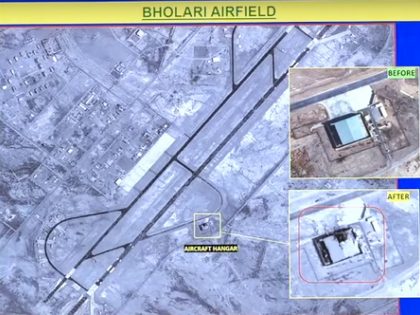'Operation Sindoor' aftermath: Multiple losses for Pakistan air force, key gains for India
By IANS | Updated: May 14, 2025 12:02 IST2025-05-14T11:56:36+5:302025-05-14T12:02:44+5:30
New Delhi, May 14 As the dust settles, a week after India’s 'Operation Sindoor', the quantum of losses ...

'Operation Sindoor' aftermath: Multiple losses for Pakistan air force, key gains for India
New Delhi, May 14 As the dust settles, a week after India’s 'Operation Sindoor', the quantum of losses and devastation on the Pakistani side is beginning to emerge, spotlighting how it was made to pay a heavy price for abetting and sponsoring terrorism in the Indian territory.
Latest reports, citing top sources claim that Pakistan air force has suffered severe losses, with 20 per cent of its infrastructure destroyed in Indian strikes.
Many of its fighter jets have been destroyed while more than 30-40 of its armymen are understood to have succumbed.
The 'Operation Sindoor' started on May 7, with India launching calculated, calibrated and measured strikes on terror hubs in Pakistan as well as Pakistan-occupied-Kashmir, however, the Pakistani establishment considered it an attack on its own and made failed attempts to target Indian military and civilian structures with its drones and missiles in India.
Responding to this, Indian armed forces launched aggressive strikes, bombing many of Pakistan's airbases with indigenous and Israeli weapons.
India targeted at least 10-11 airbases in Pakistan, many of whom are known to host the country’s key fighter jets. The strikes caused severe damages, destroying ammunition depots and airbases such as Sargodha and Bholari, where the PAF’s F-16 and J-17 fighter aircraft were said to be stationed.
Many of Pakistani fighter jets were destroyed while 50 individuals including Squadron Leader Usman Yusuf along with four airmen, were killed in the strike on the Bholari airbase in Jamshoro district of Sindh.
Pakistan Army also admitted on Tuesday that 11 of its military service personnel died and over 70 were injured in last week's conflict with India over the Pahalgam terror attack.
Indian Armed forces, however, stated on record that 35-40 Pakistani armymen were killed in strikes, from May 7 to May 10.
Top government officials have revealed that besides destruction of 20 per cent of Pakistan’s air force assets, the strikes also damaged Pakistan’s fighter jets, including the China-made JF-17.
India targeted military installations and the airbases of Nur Khan in Chaklala, Rafiqui in Shorkot, Murid in Chakwal, Sukkur, Sialkot, Pasrur, Chunian, Sargodha, Skardu, Bholari and Jacobabad.
The satellite images are showing the scale of destruction at many airbases including Shahbaz airbase in Jacobabad.
High-resolution satellite images reveal damages inflicted on mutiple airbases in Sukkur (Sindh), Nur Khan (Rawalpindi), Rahim Yar Khan (southern Punjab), Mushaf in Sargodha, Jacobabad (northern Sindh), and Bholari (northern Thatta district).
In the satellite imagery, large craters on the runways and damaged aircraft hangars were seen.
How India gained from Operation Sindoor:
For India, Operation Sindoor marked a paradigm shift in its response to acts of terror and also revealed a new doctrine in the country’s counter-terrorism operations.
Prime Minister Narendra Modi categorically stated that this will be treated as the new normal and any misadventures from Pakistani side will see bigger reprisal.
India not only destroyed nine high-value terror launchpads linked to Lashkar-e-Taiba, Jaish-e-Mohammed, and Hizbul Mujahideen but also hit deep into Pakistan’s heartland, highlighting that the acts of terror will not go unpunished now.
Strategic locations like Bahalwapur and Mudrike were targeted, signalling India’s resolve to hit targets deep inside Pakistan if the latter doesn’t stop nurturing terrorists on its soil.
'Operation Sindoor' signaled a doctrinal shift in India’s strategy and also underlined a new red line that Pakistan could no longer ignore.
The 23-minute mission demonstrated India’s air defence capabilities and exposed significant gaps in Pakistan’s air defence network, which was either bypassed or neutralised.
India’s air defence system also proved its mettle before the world, as no Pakistani projectile or missile could reach intended targets.
'Operation Sindoor' also sent a global message that India will decide on its matters, even if it includes vapourising terror targets in another country and it wouldn’t allow any foreign power’s intervention in the matter.
Therefore, in contrast to previous conflicts, where India was urged to show restraint, this time the world’s leading powers largely expressed support for India’s right to defend its citizens and territory.
'Operation Sindoor' also helped consolidate India’s narrative around Kashmir. For the first time, the Kashmir issue was de-hyphenated from India’s right to act against terror as Prime Minister stated in clear terms that talks with Pakistan could happen only on two issues – terrorism and return of PoK.
Disclaimer: This post has been auto-published from an agency feed without any modifications to the text and has not been reviewed by an editor
Open in app